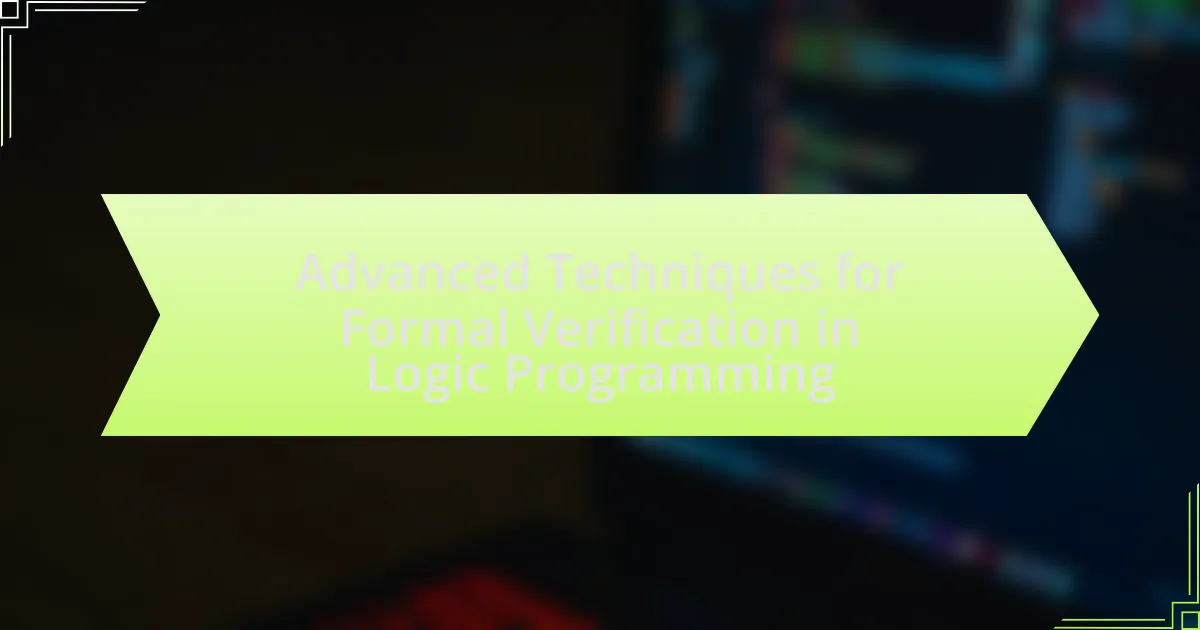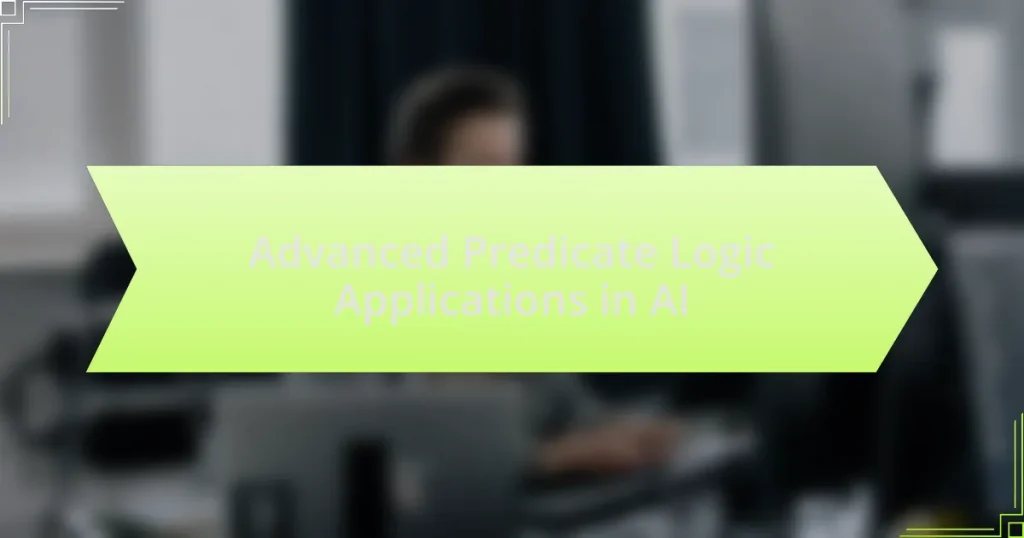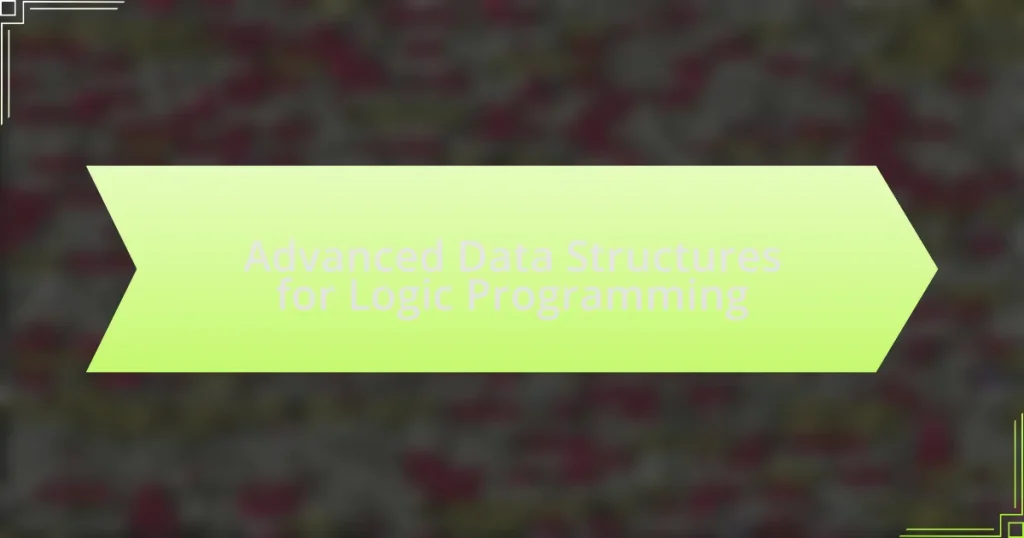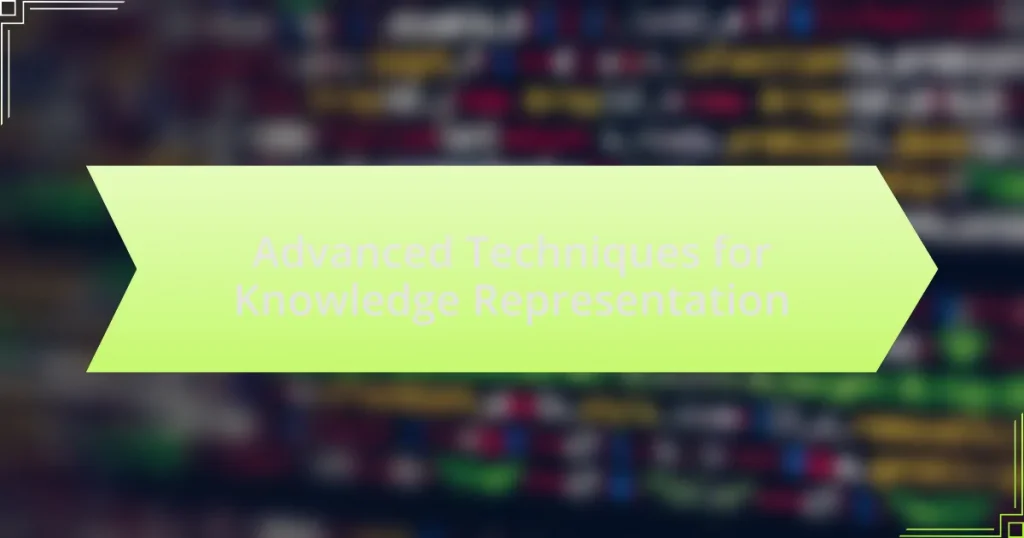Advanced techniques for formal verification in logic programming encompass model checking, theorem proving, and abstract interpretation, which are essential for ensuring program correctness and reliability. These methodologies systematically verify that logic programs adhere to specified properties, addressing challenges such as non-determinism and efficiency. The article explores how these techniques enhance software quality assurance, their practical applications across various industries, and the best practices for integrating formal verification into development workflows. Additionally, it highlights the limitations of model checking and the role of theorem proving in validating complex systems, emphasizing the importance of rigorous verification in safety-critical applications.

What are Advanced Techniques for Formal Verification in Logic Programming?
Advanced techniques for formal verification in logic programming include model checking, theorem proving, and abstract interpretation. Model checking systematically explores the state space of a program to verify properties against a formal specification, ensuring correctness in finite-state systems. Theorem proving involves using logical deductions to prove the correctness of programs, often employing tools like Coq or Isabelle to assist in the verification process. Abstract interpretation provides a framework for analyzing programs by approximating their behaviors, allowing for the detection of potential errors without exhaustive testing. These techniques are validated by their application in various programming languages and systems, demonstrating their effectiveness in ensuring program reliability and correctness.
How do these techniques enhance the reliability of logic programming?
Advanced techniques for formal verification in logic programming enhance reliability by systematically ensuring that programs adhere to specified logical properties. These techniques, such as model checking and theorem proving, provide rigorous frameworks for verifying correctness, thereby reducing the likelihood of errors. For instance, model checking can automatically explore all possible states of a program to confirm that it meets its specifications, while theorem proving allows for the formal demonstration of correctness through logical deductions. This systematic approach to verification has been shown to significantly decrease the incidence of bugs and inconsistencies in logic programs, as evidenced by studies that highlight reduced error rates in verified systems compared to unverified ones.
What specific challenges do these techniques address in logic programming?
These techniques address challenges such as ensuring correctness, handling non-determinism, and improving efficiency in logic programming. Specifically, they provide formal methods to verify that logic programs adhere to specified properties, thus preventing errors in program execution. For instance, model checking and theorem proving are employed to systematically explore program states and validate logical assertions, which mitigates the risk of runtime failures. Additionally, these techniques optimize resource usage by analyzing program behavior, leading to more efficient execution paths and reduced computational overhead.
How do these techniques compare to traditional verification methods?
Advanced techniques for formal verification in logic programming offer greater efficiency and accuracy compared to traditional verification methods. Traditional methods often rely on manual proofs and exhaustive testing, which can be time-consuming and prone to human error. In contrast, advanced techniques utilize automated reasoning and model checking, enabling faster identification of errors and verification of properties in complex systems. For instance, model checking can systematically explore all possible states of a system, ensuring comprehensive coverage that manual methods may miss. This efficiency is supported by empirical studies showing that automated techniques can reduce verification time by up to 90% in certain applications, demonstrating their superiority over traditional approaches.
Why is formal verification important in logic programming?
Formal verification is important in logic programming because it ensures the correctness and reliability of programs by mathematically proving that they adhere to specified properties. This process helps identify and eliminate errors early in the development cycle, reducing the risk of failures in critical applications. For instance, formal verification techniques such as model checking and theorem proving have been successfully applied in verifying software for safety-critical systems, demonstrating their effectiveness in enhancing program reliability.
What are the potential consequences of inadequate verification?
Inadequate verification can lead to significant errors in logic programming, resulting in incorrect program behavior and potential system failures. These failures can manifest as security vulnerabilities, where unverified code may allow unauthorized access or data breaches, as evidenced by incidents like the Equifax data breach in 2017, which was partly due to unpatched vulnerabilities. Additionally, inadequate verification can cause increased maintenance costs, as developers must spend more time debugging and fixing issues that arise from unverified code. This is supported by a study from the National Institute of Standards and Technology, which estimates that fixing defects after deployment can cost up to 30 times more than addressing them during the design phase. Overall, the consequences of inadequate verification can severely impact both the reliability of software systems and the financial resources of organizations.
How does formal verification contribute to software quality assurance?
Formal verification enhances software quality assurance by providing mathematically rigorous methods to prove the correctness of software systems. This process involves the use of formal methods, such as model checking and theorem proving, which systematically analyze software to ensure it meets specified requirements without errors. For instance, a study by Clarke et al. in 2001 demonstrated that model checking could effectively identify bugs in complex systems, thereby improving reliability. By applying formal verification techniques, developers can detect and eliminate potential flaws early in the development cycle, leading to higher quality software and reduced costs associated with post-deployment fixes.
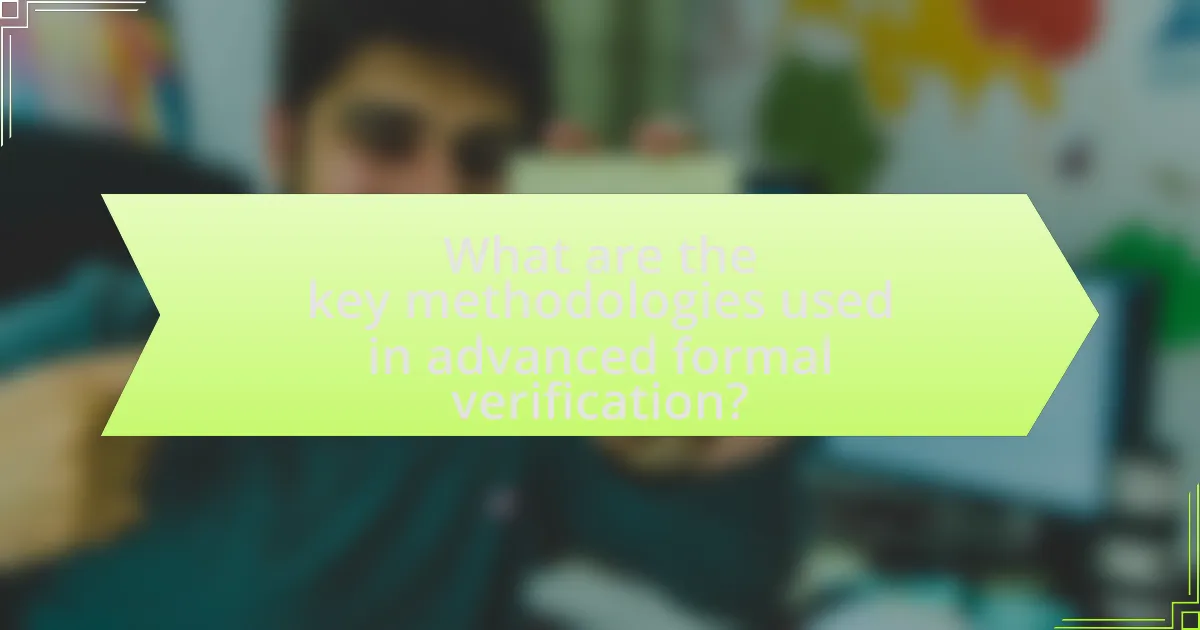
What are the key methodologies used in advanced formal verification?
The key methodologies used in advanced formal verification include model checking, theorem proving, and abstract interpretation. Model checking systematically explores the state space of a system to verify properties, often using temporal logic to express specifications. Theorem proving involves the use of logical reasoning to prove the correctness of systems based on formal specifications, utilizing tools like Coq or Isabelle. Abstract interpretation provides a framework for analyzing programs by approximating their behaviors, allowing for the detection of potential errors without exhaustive testing. These methodologies are foundational in ensuring the reliability and correctness of software and hardware systems.
How does model checking function in the context of logic programming?
Model checking functions in the context of logic programming by systematically verifying whether a given model satisfies specific properties expressed in a formal logic. This process involves creating a finite-state representation of the logic program and then exploring all possible states to ensure that the desired properties hold true across all scenarios. For instance, model checking can be applied to logic programs to confirm that certain safety or liveness properties are maintained, which is crucial for ensuring the correctness of software systems. The effectiveness of model checking in this context is supported by its ability to automatically detect errors in logic programs, as demonstrated in various studies, such as “Model Checking for Logic Programs” by E. M. Clarke et al., which illustrates the practical applications and benefits of this technique in formal verification.
What are the limitations of model checking in formal verification?
Model checking in formal verification has several limitations, including state explosion, limited expressiveness, and the requirement for complete system models. State explosion occurs when the number of states in the system grows exponentially with the number of variables, making it infeasible to analyze large systems. Limited expressiveness refers to the inability of certain model checking techniques to handle specific properties or complex behaviors, such as real-time constraints or infinite state spaces. Additionally, model checking requires a complete and accurate model of the system, which can be challenging to obtain, especially for complex or evolving systems. These limitations hinder the applicability of model checking in various scenarios, particularly in large-scale or dynamic environments.
How can model checking be optimized for better performance?
Model checking can be optimized for better performance through techniques such as abstraction, reduction, and incremental checking. Abstraction simplifies the model by removing irrelevant details, which reduces the state space and speeds up verification. Reduction techniques, like symmetry reduction, eliminate redundant states, further minimizing the computational effort required. Incremental checking allows for the reuse of previously computed results when the model changes slightly, thus avoiding complete re-evaluation. These methods have been validated in various studies, such as the work by Clarke et al. in “Model Checking” (2000), which demonstrates significant performance improvements in practical applications.
What role do theorem proving techniques play in formal verification?
Theorem proving techniques are essential in formal verification as they provide a rigorous method for proving the correctness of systems against specified properties. These techniques utilize mathematical logic to construct formal proofs that demonstrate whether a system adheres to its specifications, ensuring reliability and safety in critical applications. For instance, in software verification, theorem proving can confirm that a program behaves as intended under all possible inputs, thereby preventing errors that could lead to system failures. The effectiveness of theorem proving is evidenced by its application in various high-stakes domains, such as aerospace and automotive industries, where formal verification has been successfully employed to validate complex systems, ensuring compliance with stringent safety standards.
How do automated theorem provers differ from interactive ones?
Automated theorem provers operate independently to derive proofs without human intervention, while interactive theorem provers require user input and guidance throughout the proof process. Automated provers utilize algorithms and heuristics to explore proof spaces automatically, often relying on techniques like resolution or tableaux methods, which can lead to faster proof generation in many cases. In contrast, interactive provers allow users to construct proofs step-by-step, providing a more controlled environment for complex proofs, which can be beneficial for educational purposes or when dealing with intricate logical structures. This distinction is crucial in formal verification, as automated systems can handle larger problems quickly, while interactive systems offer flexibility and user engagement for detailed reasoning tasks.
What are the advantages of using theorem proving in logic programming?
The advantages of using theorem proving in logic programming include enhanced correctness, automated reasoning, and formal verification capabilities. Theorem proving allows for the rigorous validation of logical statements and programs, ensuring that they adhere to specified properties and behaviors. This method provides a systematic approach to proving the correctness of algorithms, which is crucial in safety-critical applications such as aerospace and medical systems. Additionally, theorem provers can automate the reasoning process, reducing the manual effort required in verifying complex systems. Studies have shown that formal verification through theorem proving can significantly decrease the number of errors in software, leading to more reliable and maintainable code.

What are the practical applications of advanced formal verification techniques?
Advanced formal verification techniques are practically applied in various domains, including software development, hardware design, and safety-critical systems. In software development, these techniques ensure that programs adhere to specified properties, reducing bugs and vulnerabilities; for instance, model checking is used to verify concurrent systems, as demonstrated in the verification of the Linux kernel. In hardware design, formal verification methods like theorem proving are employed to validate circuit designs, ensuring they function correctly under all conditions, which is crucial in industries such as aerospace and automotive. Additionally, in safety-critical systems, such as medical devices and autonomous vehicles, formal verification guarantees compliance with safety standards, thereby preventing catastrophic failures. These applications highlight the importance of advanced formal verification techniques in enhancing reliability and safety across multiple sectors.
How are these techniques applied in real-world software development?
Advanced techniques for formal verification in logic programming are applied in real-world software development primarily through automated theorem proving and model checking. These methods ensure that software systems adhere to specified properties, thereby reducing bugs and enhancing reliability. For instance, companies like Microsoft and Google utilize model checking in their software development processes to verify the correctness of critical systems, such as operating systems and distributed applications. Research has shown that formal verification can significantly decrease the number of defects in software; a study by Henzinger et al. (2015) demonstrated that formal methods can reduce software errors by up to 40% in complex systems. This application of formal verification techniques leads to higher quality software and increased confidence in system behavior.
What industries benefit most from these verification techniques?
The industries that benefit most from advanced verification techniques in logic programming include software development, finance, healthcare, and telecommunications. Software development relies on these techniques to ensure code correctness and reliability, reducing bugs and enhancing software quality. In finance, verification techniques help validate algorithms used in trading systems, ensuring compliance and minimizing risks. The healthcare industry utilizes these methods to verify software in medical devices, ensuring patient safety and regulatory compliance. Telecommunications companies apply verification techniques to maintain the integrity of communication protocols, ensuring reliable service delivery. These industries leverage formal verification to enhance system reliability, safety, and compliance with industry standards.
How do these techniques improve safety-critical systems?
Advanced techniques for formal verification in logic programming enhance safety-critical systems by ensuring that software behaves as intended under all specified conditions. These techniques systematically analyze code to identify potential errors, vulnerabilities, and compliance with safety requirements, thereby reducing the risk of failures. For instance, formal methods like model checking and theorem proving can mathematically verify that a system adheres to safety properties, which is crucial in domains such as aerospace and medical devices where failures can have catastrophic consequences. Studies have shown that employing formal verification can lead to a significant decrease in the number of defects in safety-critical systems, improving overall reliability and safety.
What are the best practices for implementing formal verification in projects?
The best practices for implementing formal verification in projects include defining clear specifications, selecting appropriate verification tools, and integrating verification into the development process. Clear specifications ensure that the requirements are unambiguous and testable, which is crucial for effective verification. Choosing the right tools, such as model checkers or theorem provers, is essential as different tools have varying strengths depending on the project’s needs. Additionally, integrating formal verification into the development lifecycle, rather than treating it as a separate phase, promotes continuous validation and helps identify issues early. These practices are supported by industry standards, such as the IEEE 1012 standard for software verification and validation, which emphasizes the importance of thorough documentation and systematic approaches in formal verification.
How can teams effectively integrate formal verification into their workflows?
Teams can effectively integrate formal verification into their workflows by adopting a systematic approach that includes training, tool selection, and process alignment. Training team members on formal verification principles and tools ensures they understand its importance and application. Selecting appropriate formal verification tools, such as model checkers or theorem provers, tailored to the specific programming logic used in projects enhances efficiency. Aligning formal verification processes with existing development methodologies, such as Agile or DevOps, facilitates seamless integration and encourages regular verification practices. This structured approach has been shown to reduce bugs and improve software reliability, as evidenced by studies indicating that formal verification can catch up to 90% of errors before deployment.
What common pitfalls should be avoided during implementation?
Common pitfalls to avoid during implementation of advanced techniques for formal verification in logic programming include inadequate requirement analysis, insufficient testing, and neglecting documentation. Inadequate requirement analysis can lead to misunderstandings of the system’s needs, resulting in a verification process that does not align with the actual goals. Insufficient testing may cause undetected errors, undermining the reliability of the verification outcomes. Neglecting documentation can hinder future maintenance and understanding of the verification process, making it difficult for others to follow or build upon the work. These pitfalls are critical as they can compromise the effectiveness and efficiency of the implementation, ultimately affecting the overall success of the verification efforts.
